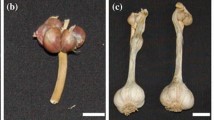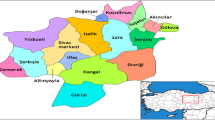Abstract
In the present study, we examined the phenotypic diversity of Greek garlic (Allium sativum L.) genotypes using morphological descriptors derived from IPGRI and UPOV. Thirty-four garlic genotypes were cultivated at two different locations: (a) Velestino, Magnesia, Region of Thessaly, and (b) Kavasila, Ilia, Region of Western Greece. The garlic genotypes were characterized using twenty-seven morphological descriptors and four quantitative characters, namely bulb dry matter, chlorophyll content in the leaf, yield and total soluble solids (°Brix) of plants and raw bulbs. The Shannon–Weaver (H′) phenotypic diversity index varied among the genotypes, although identical mean values (0.79) were recorded for both fields. Traits, such as flowering stem length, bulb skin color, skin color of the clove presented low (H′) values indicating a high coefficient of heritability and less environmental effect. Principal component analysis based on morphological characters showed that the first seven axes could explain 71.49% and 75.86% of total variation for Kavasila and Velestino fields respectively. Significant differences were also observed among the garlic genotypes for the quantitative characters studied. Furthermore, significant statistical correlations were recorded for specific characters between the two cultivation sites e.g. yield with weight of cloves (r = 0.55 and r = 0.62) and number of cloves per bulb with weight of cloves (r = −0.51 and r = −0.55), which could be exploited further in future breeding programs. In conclusion, the high phenotypic diversity observed among the garlic genotypes could be attributed to various factors such as the genotype, the cultivation practices and the environmental conditions.




Similar content being viewed by others
References
Baghalian K, Ziai SA, Naghavi MR, Badi HN, Khalighi A (2005) Evaluation of allicin content and botanical traits in Iranian garlic (Allium sativum L.) ecotypes. Sci Hortic 103(2):155–166. https://doi.org/10.1016/j.scienta.2004.07.001
Batth GS, Kumar H, Gupta V, Brar PS (2013) GGE biplot analysis for characterization of garlic (Allium sativum L.) germplasm based on agro-morphological traits. Int J Plant Breed 7(2):106–110
Bhatt B, Soni AK, Jangid K, Kumar S (2017) A study on genetic variability, character association and path coefficient analysis in promising indigenous genotypes of garlic (Allium sativum L.). Int J Pure App Biosci 5(1):679–686. https://doi.org/10.18782/2320-7051.2464
Chotaliya P, Kulkarni GU (2017) Character association and path analysis for quantitative traits in garlic (Allium sativum L.). Int J Curr Microbiol App Sci 6(8):175–184. https://doi.org/10.20546/ijcmas.2017.608.025
de Lucena RRM, de Negreiros MZ, de Morais PLD, Lopes WDAR, Soares AM (2016) Qualitative analysis of vernalizated semi-noble garlic cultivars in western Rio Grande do Norte State. Brazil. Rev Caatinga 29(3):764–773. https://doi.org/10.1590/1983-21252016v29n329rc
Diriba-Shiferaw G, Nigussie-Dechassa R, Kebede W, Getachew T, Sharma JJ (2013) Growth and nutrients content and uptake of Garlic (Allium sativum L.) as influenced by different types of fertilizers and soils. Sci Technol Arts Res J 2:35–50. https://doi.org/10.4314/star.v2i3.98727
Draghi JA, Whitlock MC (2012) Phenotypic plasticity facilitates mutational variance, genetic variance, and evolvability along the major axis of environmental variation. Evolution 66(9):2891–2902. https://doi.org/10.1111/j.1558-5646.2012.01649.x
Eticha F, Bekele E, Belay G, Börner A (2005) Phenotypic diversity in tetraploid wheats collected from Bale and Wello regions of Ethiopia. Plant Genet Resour 3(1):35–43. https://doi.org/10.1079/PGR200457
Etoh T, Simon PW (2002) Diversity, fertility and seed production of garlic. In: Rabinowitch HD, Currah L (eds) Allium crop science: recent advances, 1st edn. CABI publishing, Wallingford, Oxford, pp 101–117. https://doi.org/10.1079/9780851995106.0101
Fanaei H, Narouirad M, Farzanjo M, Ghasemi M (2014) Evaluation of yield and some agronomical traits in garlic genotypes (Allium sativum L.). Annu Res Rev Biol 4(22):3386–3391. https://doi.org/10.9734/ARRB/2014/9090
Hanelt MJ, Schulze-Motel Fritsch RM, Kruse J, Maass H, Ohle H, Pistrick K (1992) Infrageneric approach. In: Hanelt P, Hammer K, Pistrick H (eds) The genus Allium—taxonomic problems and genetic resources. Gatersleben, Germany, pp 107–123
Harris JC, Cottrell SL, Plummer S, Lloyd D (2001) Antimicrobial properties of Allium sativum L. (garlic). Appl Microbiol Biotechnol 57(3):282–286. https://doi.org/10.1007/s002530100722
Hirata S, Abdelrahman M, Yamauchi N, Shigyo M (2016) Diversity evaluation based on morphological, physiological and isozyme variation in genetic resources of garlic (Allium sativum L.) collected worldwide. Genes Genet Syst 91(3):161–173. https://doi.org/10.1266/ggs.15-00004
Hoogerheide ESS, Azevedo Filho JA, Vencovsky R, Zucchi MI, Zago BW, Pinheiro JB (2017) Genetic variability of garlic accessions as revealed by agro-morphological traits evaluated under different environments. Genet Mol Res 16(2):1–10. https://doi.org/10.4238/gmr16029612
Ipek M, Ipek A, Almquist SG, Simon PW (2005) Demonstration of linkage and development of the first low-density genetic map of garlic, based on AFLP markers. Τheor Appl Genet 110(2):228–236. https://doi.org/10.1007/s00122-004-1815-5
IPGRI (2001) Descriptors for Allium spp International Plant Genetic Resources Intitute. Rome, Italy. https://www.bioversityinternational.org/fileadmin/user_upload/online_library/publications/pdfs/728.pdf
Jabbes N, Arnault I, Auger J, Dridi BAM, Hannachi C (2012) Agro-morphological markers and organo-sulphur compounds to assess diversity in Tunisian garlic landraces. Sci Hortic 148:47–54. https://doi.org/10.1016/j.scienta.2012.08.013
Kaushik S, Kumar M, Prakash S, Kumar V, Singh MK, Singh B, Malik S, Singh K (2016) Study of genetic diversity in garlic (Allium sativum L.) by using morphological characters. Prog Agric 16(2):204–210. https://doi.org/10.5958/0976-4615.2016.00038.7
Khan H, Ηussain MM, Jellani G, Hidayatullah Tariq S, Naseeb T, Mahmood S (2018) Evaluation of garlic genotypes for yield and yield components in Islamabad, Pakistan environment. Nucleus 55(1):22–26
Kumar M (2015) Morphological characterization of garlic (Allium sativum L.) germplasm. J Plant Develop Sci 7(5):473–474
Kumar S, Samnotra RK, Kumar M, Khar S (2015) Character associaton and path analysis in garlic (Allium spp.) germplasm under sub tropical enviroment of Jammu. Bioscan 10:1997–2003
McCollumn GD (1987) Onion and allies. In: Smartt J, Simmonds NW (eds) Evolution of crop plants, 2nd edn. Longman, London, pp 186–190
Mohammadi B, Khodadadi M, Karami E, Shaaf S (2014) Variation in agro-morphological characters in Iranian garlic landraces. Int J Veg Sci 20(3):202:215. doi:10.1080/19315260.2013.788594.
Panthee DR, Kc RB, Regmi HN, Subedi PP, Bhattarai S, Dhakal J (2006) Diversity analysis of garlic (Allium sativum L.) germplasms Aavailable in Nepal based on morphological characters. Genet Resour Crop Evol 53(1):205–212. https://doi.org/10.1007/s10722-004-6690-z
Paredes MC, Becerra VV, González MIA (2008) Low genetic diversity among garlic (Allium sativum L.) accessions detected using random amplified polymorphic DNA (RAPD). Chil J Agr Res 68(1):3–12. https://doi.org/10.4067/s0718-58392008000100001
Petropoulos SA, Fernandes Â, Ntatsi G, Petrotos K, Barros L, Ferreira ICFR (2018) Nutritional value, chemical characterization and bulb morphology of Greek garlic landraces. Molecules 23(319):1–14. https://doi.org/10.3390/molecules23020319
Raja H, Ram CN, Sriom, Bhargav KK, Pandey M, Jain A (2017) Genetic variability assessment in garlic (Allium sativum L.) genotypes. J Pharmacogn Phytochem 6(6):1781–1786
Sabir M, Singh D, Jat BL (2017) Study of morphological and molecular characterization of garlic (Allium sativum L.). Asian J Hort 12(1):141–159. https://doi.org/10.15740/HAS/TAJH/12.1/141-159
Shandhu SS, Brar PS, Dhall RK (2015) Variability of agronomic and quality characteristics of garlic (Allium sativum L.) ecotypes. SABRAO J Breed Genet 47:133–142
Sharma VR, Malik S, Kumar M, Sirohi A (2018) Morphological classification of genetic diversity of garlic (Allium sativum L.) germplasm for bulb and yield-related traits using principal component analysis. Int J Curr Microbiol Appl Sci 7(6):2016–2022. https://doi.org/10.20546/ijcmas.2018.706.238
Sharma VR, Omotayo K, Malik S, Kumar M, Sirohi A (2016) Character association and path analysis in garlic (Allium sativum L.). The Bioscan 11(3):1931–1935
Simon P.W. (2001) The origins and distribution of garlic: how many garlics are there? USDA, ARS, Vegetable Crop Research Unit, Department of Horticulture, University of Wisconsin, Madison.
Singh G, Ram CN, Singh A, Shrivastav SP, Maurya PK, Kumar P (2018) Genetic variability, heritability, and genetic advance for yield and its contributing traits in garlic. Int J Curr Microbiol App Sci 7:1362–1372. https://doi.org/10.20546/ijcmas.2018.702.165
Singh L, Kaul V, Gohil RN (2014) Analysis of morphological variability in the Indian germplasm of Allium sativum L. Plant Syst Evol 300(2):245–254. https://doi.org/10.1007/s00606-013-0877-8
Singh RK, Dubey BK, Gupta RP (2012) Studies on variability and genetic divergence in elite lines of garlic (Allium sativum L.). J Spices Aromat Crops 21(2):36–144
Singh RK, Dubey BK, Bhonde SR, Gupta RP (2011) Correlation and path analysis studies in garlic (Allium sativum L.). J Spices Aromat Crops 20(2):81–85
Terzopoulos P, Bebeli PJ (2010) Phenotypic diversity in Greek tomato (Solanum lycopersicum L) genotypes. Sci Hortic. 126(2):138–144. https://doi.org/10.1016/j.scienta.2010.06.022
Trani PE, Passos FA, Foltran DE, Tivelli SW, Ribeiro IJA (2005) Evaluation of garlic accesses from the collection of the Instituto Agronômico de Campinas. Ηortic Bras 23:935–939. https://doi.org/10.1590/S0102-05362005000400015
UPOV (2001) Guidelines for the conduct of tests for distinctness, uniformity and stability International Union for the protection of new varieties of plans. Genova, Italy. https://www.upov.int/edocs/tgdocs/en/tg162.pdf
Velisek J, Kubec R, Davidek J (1997) Chemical composition and classification of culinary and pharmaceutical garlic-based products. Eur Food Res Technol 204(2):161–164. https://doi.org/10.1007/s002170050054
Vieira RL, Nodari RO (2007) Genetic diversity of garlic revealed by RAPD markers. Cienc Rural 37(1):51–57. https://doi.org/10.1590/s0103-84782007000100009
Wang H, Li X, Shen D, Oiu Y, Song J (2014) Diversity evaluation of morphological traits and allicin content in garlic (Allium sativum L.) from China. Euphytica 198(2):243–254. https://doi.org/10.1007/s10681-014-1097-1
Yeshiwas Y, Negash B (2017) Genetic variability, heritability and genetic advance of growth and yield components of garlic (Allium sativum L.) germplasms. J Biol Agric Healthc 7(21):84–91
Acknowledgements
We would like to thank Dr. R. Thanopoulos from Agricultural University of Athens, for participating in the collection of the plant material, the farmers that shared with us the bulbs of their landraces used in this study. We would also like to thank the anonymous reviewers for their valuable comments and suggestions to improve the manuscript.
Author information
Authors and Affiliations
Corresponding author
Ethics declarations
Conflict of interest
The authors declare no conflicts of interest.
Additional information
Publisher's Note
Springer Nature remains neutral with regard to jurisdictional claims in published maps and institutional affiliations.
Electronic supplementary material
Below is the link to the electronic supplementary material.
Rights and permissions
About this article
Cite this article
Polyzos, N., Papasotiropoulos, V., Lamari, F.N. et al. Phenotypic characterization and quality traits of Greek garlic (Allium sativum L.) germplasm cultivated at two different locations. Genet Resour Crop Evol 66, 1671–1689 (2019). https://doi.org/10.1007/s10722-019-00831-4
Received:
Accepted:
Published:
Issue Date:
DOI: https://doi.org/10.1007/s10722-019-00831-4




